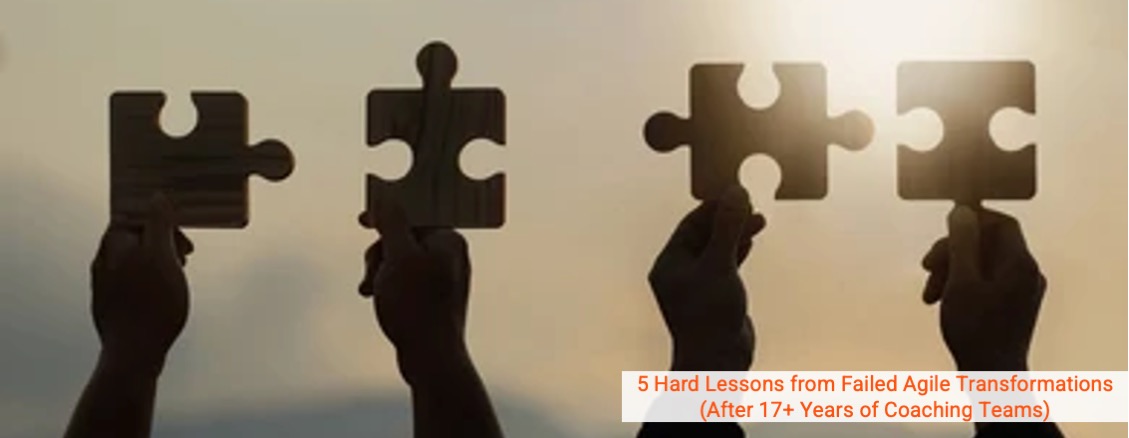After working with over 5,000 professionals and leading Agile coaching programs in dozens of industries, I’m sharing five hard lessons learned from failed Agile transformations to help you avoid common pitfalls.
Agile transformations often fail not because of tools or frameworks, but due to cultural and human challenges. Understanding these lessons is crucial for anyone involved in Agile change initiatives to increase their chances of success.
Most Agile transformations fail because they focus on processes and tools rather than culture and mindset. Without psychological safety, leadership support, and continuous learning, teams revert to old habits and fail to achieve true agility.
5 Hard Lessons from Failed Agile Transformations (After 17+ Years of Coaching Teams)
After working with over 5,000 professionals and leading Agile coaching programs in dozens of industries, I’ve seen one thing too often: Agile transformations fail.
Not because of lack of tools or frameworks.
But because the real challenges are cultural and human.
In this post, I’m breaking down 5 hard lessons I’ve learned while supporting teams through Agile change initiatives. If you’re involved in any kind of Agile transformation—at any level—read this before your next standup.
Lesson 1: New Processes Don’t Fix Old Culture
Most teams start here—scrum boards, Jira, daily standups.
It feels like progress, but it’s surface level.
Agile isn’t about tools. It’s about mindset. Old habits and rigid hierarchies don’t dissolve because you hold a retrospective.
One client invested six figures in Agile tooling and certifications. Still missed their delivery targets. Because leadership continued micromanaging and risk-avoidant behavior was rewarded.
Start with culture. Ask: What behaviors are we reinforcing? What does safety look like on this team?
Lesson 2: Without Psychological Safety, Agile Becomes Risky
Agile thrives when people feel safe to speak up.
No one will challenge the status quo or admit mistakes if there’s fear of blame.
I was once brought in on a project stalled for three months. During the first team session, an engineer finally admitted they didn’t understand the product goal—but waited because speaking up meant risking their standing.
People learn to stay quiet in unsafe spaces. That kills Agile.
Create team rituals that normalize imperfection. Celebrate learnings, not outcomes. It starts at the top.
Lesson 3: Middle Management Feels Like They Have the Most to Lose
We don’t talk about this enough.
As teams move toward autonomy and faster iteration, middle managers often feel sidelined. And when they’re unsure of their role, they resist.
In one organization, directors were never included in the Agile training. Post-transformation, they blocked decisions and escalated issues unnecessarily. Not out of malice—out of fear they no longer added value.
Be proactive. Redefine what support and leadership mean at every level. Involve everyone.
Middle management can be your biggest ally—if you help them transition too.
Lesson 4: Education Without Application Wastes Time
Sending teams to training isn’t enough.
Most people can repeat the Agile Manifesto after a workshop. That doesn’t mean they know how to prioritize or collaborate cross-functionally under pressure.
At a retail company I worked with, teams had completed SAFe training. But when pressure mounted during holiday season launches, they reverted to top-down planning and fire drills.
Transformation isn’t a one-time event—it’s a continuous practice.
Pair education with mentorship. Support your teams as they stumble. That’s where the learning sticks.
Lesson 5: Quick Wins Are Fine, But Real Change Takes Time
Everyone wants results by next quarter.
But meaningful transformation takes months, even years. Especially when you’re rewiring how people think, relate, and decide.
A CEO once asked me to “Agile-fy” their teams in six weeks. I smiled and asked if they were also planning to change a decade of command-and-control culture in that same timeframe.
This work will frustrate you. It will feel slow.
But you don’t scale Agile by setting deadlines. You scale it by committing to the process.
Set realistic expectations. Prioritize consistency over speed.
You’re trying to grow people, not install software.
If you’re planning or currently running an Agile transformation, remember:
The organization doesn’t change because you implement a framework. It changes because people start thinking and interacting differently. And that takes trust, courage, and patience.
Want to start strong?
Make psychological safety your foundation. Invest in culture—not just process. And support every layer of your org, especially the ones who feel left out.


0 Comments